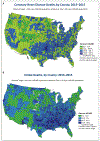Progress Toward Improved Cardiovascular Health in the United States
- PMID: 30986104
- PMCID: PMC8428048
- DOI: 10.1161/CIRCULATIONAHA.118.035408
Progress Toward Improved Cardiovascular Health in the United States
Abstract
The Healthy People Initiative has served as the leading disease prevention and health promotion roadmap for the nation since its inception in 1979. Healthy People 2020 (HP2020), the initiative's current iteration, sets a national prevention agenda with health goals and objectives by identifying nationwide health improvement priorities and providing measurable objectives and targets from 2010 to 2020. Central to the overall mission and vision of Healthy People is an emphasis on achieving health equity, eliminating health disparities, and improving health for all population groups. The Heart Disease and Stroke (HDS) Work Group of the HP2020 Initiative aims to leverage advances in biomedical science and prevention research to improve cardiovascular health across the nation. The initiative provides a platform to foster partnerships and empower professional societies and nongovernmental organizations, governments at the local, state, and national levels, and healthcare professionals to strengthen policies and improve practices related to cardiovascular health. Disparities in cardiovascular disease burden are well recognized across, for example, race/ethnicity, sex, age, and geographic region, and improvements in cardiovascular health for the entire population are only possible if such disparities are addressed through efforts that target individuals, communities, and clinical and public health systems. This article summarizes criteria for creating and tracking the 50 HDS HP2020 objectives in 3 areas (prevention, morbidity/mortality, and systems of care), reports on progress toward the 2020 targets for these objectives based on the most recent data available, and showcases examples of relevant programs led by participating agencies. Although most of the measurable objectives have reached the 2020 targets ahead of time (n=14) or are on track to meet the targets (n=7), others may not achieve the decade's targets if the current trends continue, with 3 objectives moving away from the targets. This summary illustrates the utility of HP2020 in tracking measures of cardiovascular health that are of interest to federal agencies and policymakers, professional societies, and other nongovernmental organizations. With planning for Healthy People 2030 well underway, stakeholders such as healthcare professionals can embrace collaborative opportunities to leverage existing progress and emphasize areas for improvement to maximize the Healthy People initiative's positive impact on population-level health.
Keywords: heart disease; prevention; public policy; stroke.
Figures






References
-
- U.S. Department of Health and Human Services, Centers for Disease Control and Prevention, National Center for Health Statistics. Health, United States, 2017: With special feature on mortality. 2018. https://www.cdc.gov/nchs/data/hus/hus17.pdf.Accessed March 28, 2019.
-
- Lackland DT, Roccella EJ, Deutsch AF, Fornage M, George MG, Howard G, Kissela BM, Kittner SJ, Lichtman JH, Lisabeth LD, Schwamm LH, Smith EE, Towfighi A; American Heart Association Stroke Council; Council on Cardiovascular and Stroke Nursing; Council on Quality of Care and Outcomes Research; Council on Functional Genomics and Translational Biology. Factors influencing the decline in stroke mortality: a statement from the American Heart Association/American Stroke Association. Stroke. 2014;45:315–353. doi: 10.1161/01.str.0000437068.30550.cf - DOI - PMC - PubMed
MeSH terms
Grants and funding
LinkOut - more resources
Full Text Sources

